UMET - Experimental facilities
36/5000 Synthesis, titration and formatting (41 instruments)
Electrospining (2 instruments)
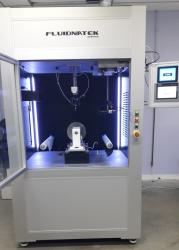
Automated electrospinning
Research team: Ingénierie des systèmes polymères.
Contact: Bernard MARTEL.
Objectives: Development of nanofiber membranes
Technical characteristics:
- Air-conditioned enclosure
- Transmitter 1 needle or 24 needles + coaxial needle
- Planar collector, rotary chuck and drum or reel for continuous electrospinning
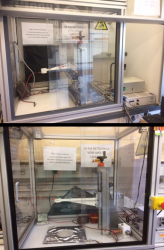
Electrospinning (home made)
Research team: Ingénierie des systèmes polymères.
Contact: Bernard MARTEL.
Development of nanofiber membranesTechnical characteristics:
- Transmitter 1 needle + coaxial needle
- Flat collector, rotary chuck and drum for production of samples 20x30 cm max
High pressure (9 instruments)
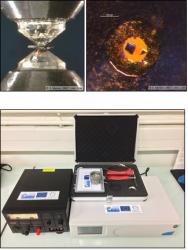
Diamond anvil cells
Research team: Earth and Planetary Materials.
Contacts: Sébastien MERKEL, Julien CHANTEL.
The diamond anvil cell allows the experimental study of mantle materials and the Earth's core. The sample is compressed between two diamonds having a flat surface with a diameter ranging from 10 to 700 μm. The properties of the sample are then studied by diffraction or spectroscopy. The laboratory has several cells, allowing in-situ experimentation at pressures above the megabar. For temperatures below 1500 K, the sample can be heated using a graphite furnace fitted inside the diamond cell. Samples can also be heated to temperatures of several thousand degrees by focusing on the sample of power lasers (10 to 100W, infra-red). This operation allows the activation of phase transitions with slow kinetics, to relax the constraints within the samples, and to reproduce the conditions of the interior of the planets. The laboratory does not have a laser heating system and we occasionally use assemblies installed in other laboratories or during our in-situ campaigns on large instruments.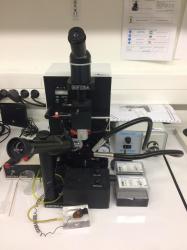
Electro-erosion drill
Research team: Earth and Planetary Materials.
Contacts: Sébastien MERKEL, Julien CHANTEL.
Fast, accurate and centered drilling of metal joints used for diamond cell experiments.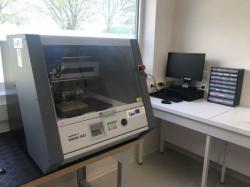
Micro digital milling machine
Research team: Earth and Planetary Materials.
Contacts: Julien CHANTEL, Nadège HILAIRET.
This tool allows the production of prototypes or small series of metal or ceramic parts for so-called 'big volume' experiments (piston-cylinder and multi-anvils).
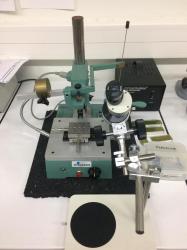
Micro-drill
Research team: Earth and Planetary Materials.
Contacts: Sébastien MERKEL, Julien CHANTEL.
Column precision drill, used for part making for so-called 'big volume' experiments (piston-cylinder and multi-anvils).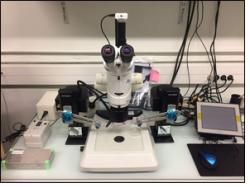
Micromanipulator
Research team: Earth and Planetary Materials.
Contacts: Sébastien MERKEL, Julien CHANTEL.
Allows handling of items smaller than 10µm when preparing diamond cell experiments.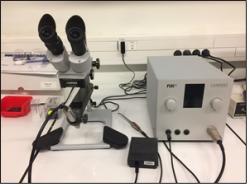
Microwave welder under neutral atmosphere
Research team: Earth and Planetary Materials.
Contacts: Julien CHANTEL, Nadège HILAIRET.
Fine welding technique by instant fastening for all metals. Used to hermetically seal the metal capsules of so-called 'big volume' experiments (piston-cylinder and multi-anvils).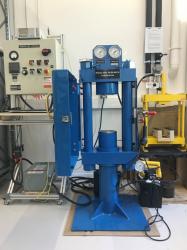
Piston-cylinder press
Research team: Earth and Planetary Materials.
Contacts: Nadège HILAIRET, Julien CHANTEL.
This press, with a solid confinement medium, allows experiments at pressures up to 4 GPa and temperatures of 1800 ° C, on samples pluri-millimeter to centimetric. This device contributes to the synthesis of innovative materials, the production of materials with controlled compositions and microstructures, the synthesis of synthetic rocks and the sintering of natural or synthetic rocks.
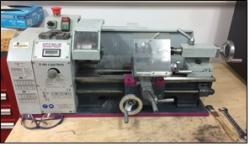
Precision tower
Research team: Earth and Planetary Materials.
Contacts: Nadège HILAIRET, Julien CHANTEL.
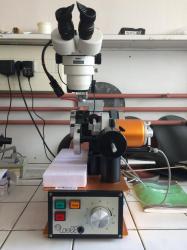
Wire saw
Research team: Earth and Planetary Materials.
Contacts: Nadège HILAIRET, Julien CHANTEL.
Precision cutting (lower than 100 µm) of metals, ceramics and samples without destruction or modification of the material.
Metallurgy and powder metallurgy (4 instruments)
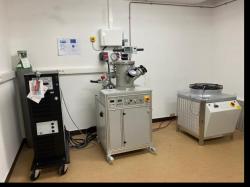
Arc Melting Furnace
Contact: Rajashekhara SHABADI.
Arc Melting is used for melting metals– typically to form alloys. Heating is via an electric arc struck between a tungsten electrode and metals placed in a depression (crucible) in the copper hearth. In vacuum arc melting the chamber is evacuated and then back filled with argon gas. Hence, melting is performed in argon atmosphere. Suction casting or tilt casting modes. Temperatures can reach upto 3500oC. Capacity upto 500gms.
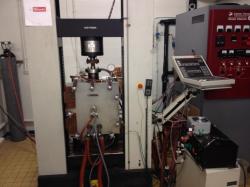
Hot press sintering
Research team: Métallurgie physique et génie des matériaux.
Contacts: Franck BÉCLIN, Matthieu TOUZIN.
Graphite furnace HT 2000 ° C under secondary vacuum or neutral atmosphere (N2, Ar, He, ...)
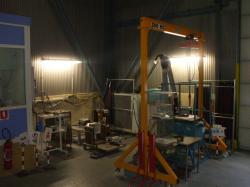
Metal Fusion Platform
Research team: Métallurgie physique et génie des matériaux.
Contact: David BALLOY.
Direct and indirect heating
Up to 20kg of steel
Resistance Tilting furnace12kW
10 liters (Al foundry + galvanizing)
+ 1 liter tilting furnace
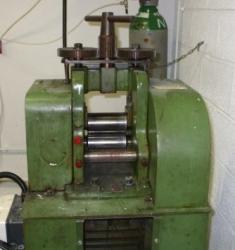
Rolling mill
Research team: Métallurgie physique et génie des matériaux.
Contacts: David BALLOY, Matthieu TOUZIN.
Maximum opening between cylinders: 37 mm
Hot rolling (preheating oven up to 1200 ° C - atmo N2)
Cold rolling
mills (6 instruments)
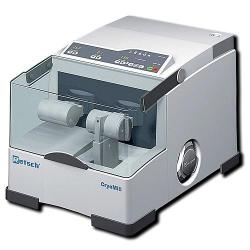
cryogenic mill (CryoMill RETSCH)
Research team: Métallurgie physique et génie des matériaux.
Contact: Catherine CORDIER.
Vibrating mill, room temperature or liquid nitrogen temperature (77K)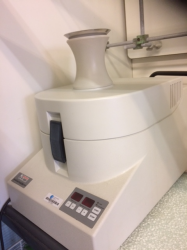
mill Fritsch PULVERISETTE
Research team: Ingénierie des systèmes polymères.
Contact: Bernard MARTEL.
for cereals, for cables, for foodstuffs, for rubber, for kakaonibs, for plastics, for wood
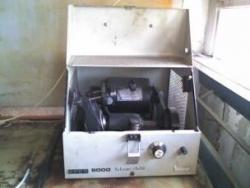
mills SPEX 8000 (high energy grinding at ambient temperature)
Research team: Métallurgie physique et génie des matériaux.
Contact: Catherine CORDIER.
Possible programming of the duration and grinding cycle;Container volume about 45 cm3;
grinding vials and balls in steel or alumina
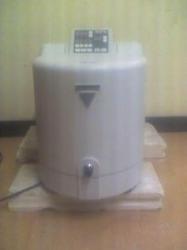
planetary mill (Fritsch)
Research team: Métallurgie physique et génie des matériaux.
Contact: Marie-Noëlle Avettand-Fénoël.
Planetary mill used for metalls and mechanical alloying.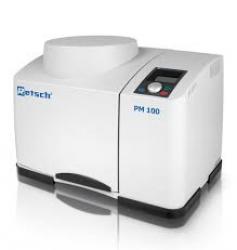
planetary mill (PM 100 Retsch)
Research team: Métallurgie physique et génie des matériaux.
Contacts: Matthieu TOUZIN, Franck BÉCLIN.
Speed up to 600 rpm;
Bowls and balls in stainless steel, tungsten carbide, agate and alumina.
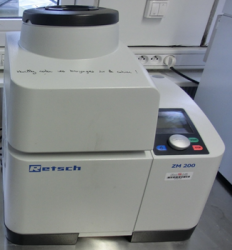
Retsch ZM200 ultracentrifugal crusher
Research team: Ingénierie des systèmes polymères.
Contact: Pierre BACHELET.
Polymer and composite shaping (9 instruments)
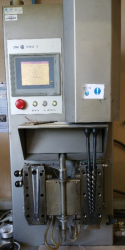
Conical Corotative Twin Screw Micro-extruder (DSM / Xplore)
Research team: Ingénierie des systèmes polymères.
Contacts: Pierre BACHELET, Johan SARAZIN.
Capacity: 15g. Max temperature 400 ° C. Coupling possible to mini injection press (several molds), mine line of spinning and film making.
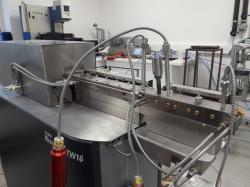
Extrudeuse CO2 supercritique
Research team: Ingénierie des systèmes polymères.
Contacts: Pierre BACHELET, Johan SARAZIN.
Supercritical carbon dioxide-assisted extrusion
Extrusion length = 640 mm (L/D = 40)
10 temperature zones
Max pressure = 100 bar
Max rotation speed = 1100 rpm
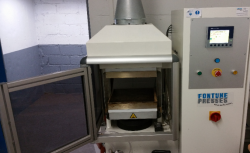
Heated platen press (Fontjine LabEcon300 Junior)
Research team: Ingénierie des systèmes polymères.
Contacts: Pierre BACHELET, Fabienne SAMYN.
Polymer materials shaping.capacity from 100 to 300kN, low pressure hydraulic system to work from 10 to 100kN, trays 320x320mm, opening between trays 200mm, operating temperature up to 300 ° C.
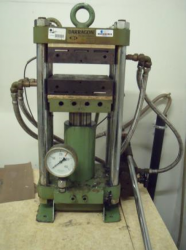
Heated platen press DARAGON
Research team: Ingénierie des systèmes polymères.
Contact: Adeline MARIN.
• Elaboration of polymer films / plates, cutting of test pieces with cutters• 2 parallel heating trays, cooling with water and air
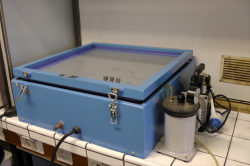
Infusion table
Research team: Ingénierie des systèmes polymères.
Contacts: Pierre BACHELET, Fabienne SAMYN.
Elaboration of composite materials.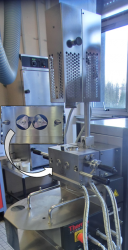
Internal mixer (Thermofisher)
Research team: Ingénierie des systèmes polymères.
Contacts: Pierre BACHELET, Johan SARAZIN.
Elaboration of charged polymeric materials.Capacity: 250g. Max temperature 400 ° C.
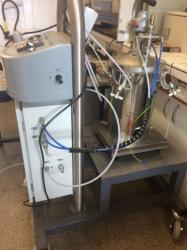
RTM System (Resin Transfer Molding)
Research team: Ingénierie des systèmes polymères.
Contacts: Pierre BACHELET, Fabienne SAMYN.
Elaboration of composite materials.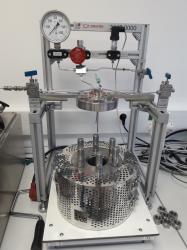
Supercritical CO2 reactor
Contacts: Pierre BACHELET, Guillaume CORJON.
Max pressure = 450 bar
Max temperature = 200°C
Volume = 250mL
Diameter x height (internal) = 55 x 105 mm
Mixing by magnetic stirrer
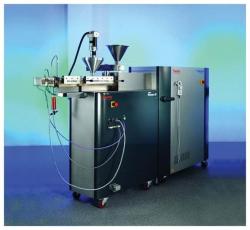
Twin-Screw corotative 16mm extruder (Thermofisher PTW16)
Contacts: Pierre BACHELET, Johan SARAZIN.
Coumpounding : equipped with volumetric and mass feeders for powder and pellets
Extrusion length = 640 mm (L/D = 40)
Achievable output : 0.2 to 2 kg/h
10 temperature zones
Max pressure = 100 bar
Max rotation speed = 1100 rpm
Max T°C = 400°C
Textile finishing platform (4 instruments)
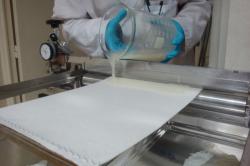
Coating table Roaches
Research team: Ingénierie des systèmes polymères.
Contact: Bernard MARTEL.
Textile finishingTechnical characteristics:
- Textile finishing process by polymer coating
- Dimensions samples 30 x 45 cm
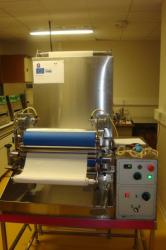
finishing rail Roaches
Research team: Ingénierie des systèmes polymères.
Technical characteristics:
- Continuous textile finishing process by padding / squeezing / drying IR / curing dry heat
- Weft roll 45cm
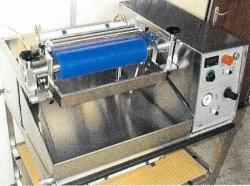
Foulard Roaches BHP
Research team: Ingénierie des systèmes polymères.
Contact: Bernard MARTEL.
Technical characteristics:
- Width 45 cm
- Horizontal scarf
- Speed <5m / min
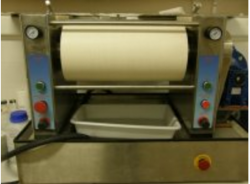
Padding system
Research team: Ingénierie des systèmes polymères.
Contact: Pierre BACHELET.
Width 500mm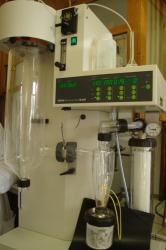
Atomizer Büchi B290
Research team: Ingénierie des systèmes polymères.
Contact: Bernard MARTEL.
Elaboration of microparticles for the encapsulation of active ingredientsTechnical characteristics:
- Particle size 2-25μm
- high-performance cyclone
- stainless steel nozzle
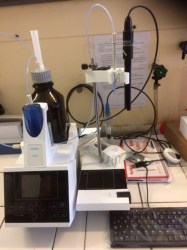
Automatic titrator TITROLINE
Research team: Ingénierie des systèmes polymères.
Contact: Jean-Noël STAELENS.
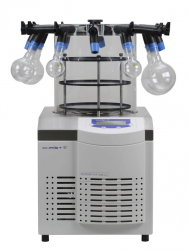
Freeze dryer Alpha 2-4 LD Plus CHRIST
Research team: Ingénierie des systèmes polymères.
Contact: Joël LYSKAWA.
Desiccation of previously frozen compounds by the sublimation processTechnical characteristics:
- Condenser temperature up to -85 ° C
- Capacity: 4Kg / 24H
- Automatic defrost
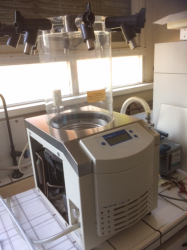
Freeze dryer CHRIST model alpha 1-2 LD
Research team: Ingénierie des systèmes polymères.
Contact: Bernard MARTEL.
Obtaining powders from aqueous solutionsTechnical characteristics :
Temperature- 55 ° C; Condenser 2.5 Kg; Capacity 2 Kg / 24h
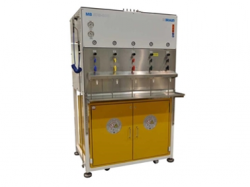
Solvent Fountain: SPS System Mbraun MBSP95
Research team: Ingénierie des systèmes polymères.
Contact: Jonathan POTIER.
Allows anhydrous solventsInert atmosphere sampling
Technical characteristics:
- Possibility of purifying up to 15 L of solvents
- Distribution rate greater than 3L.min-1
- Available solvents: DMF / Dichloromethane / Chloroform / THF
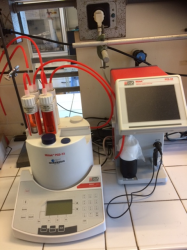
Titrator Mütek PCD-03
Research team: Ingénierie des systèmes polymères.
Contact: Jean-Noël STAELENS.
Assays of colloids in solutionTechnical characteristics:
- Automatic titration; pH regulation; measurement of ion exchange capacity
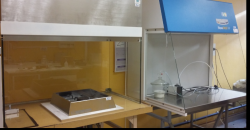
Turntable
Research team: Ingénierie des systèmes polymères.
Contact: Jean-François TAHON.
Turntable (KARL SUSS RC8)Accelerated aging tests (2 instruments)
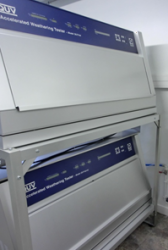
Accelerated aging speakers (Q-LAB, Q-UV and Q-SUN)
Research team: Ingénierie des systèmes polymères.
Contacts: Maude JIMENEZ, Pierre BACHELET, Johan SARAZIN.
The inclosures test the materials by exposing them to alternating cycles of UV or solar light and humidity at high and controlled temperatures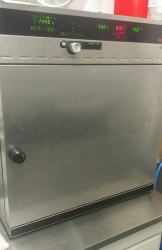
Humidity-Controlled Environmental Enclosure (Memmert HCP108L)
Research team: Ingénierie des systèmes polymères.
Contacts: Pierre BACHELET, Johan SARAZIN.
Thanks to active hygrometric control and excellent homogeneity of temperature and humidity throughout the inner chamber, it is ideal for environmental testing, accelerated life tests and 85/85 tests according to IEC 60068 standards. -2-67 and IEC 60068-2-78.
Analysis and surface treatment (22 instruments)
Surface analyzes (4 instruments)
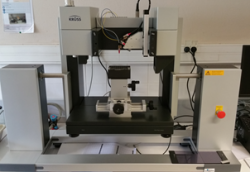
Contact angle measuring device (Kruss, DSA100)
Research team: Ingénierie des systèmes polymères.
Contact: Maude JIMENEZ.
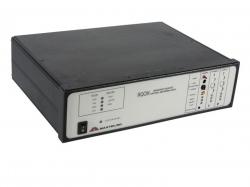
Electrochemical scale with quartz crystal Maxtek
Research team: Ingénierie des systèmes polymères.
Contact: Joël LYSKAWA.
Measurement of mass variations on the surface of an electrodeApplication: monitoring the growth of an organic film generated by electrochemistry
Technical characteristics:
- Resolution: 0.4ng / cm2
- Frequencies:: 3.8 to 6 MHz, 5.1 to 10 MHz
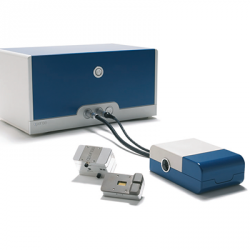
Quartz Microbalance with Dissipation QSense
Research team: Ingénierie des systèmes polymères.
Contact: Joël LYSKAWA.
Real-time analysis of molecule / surface interactions
Applications:
- Interaction studies Proteins or polymers / surface
- Real-time monitoring of the formation of organic films on the surface
Technical characteristics:
- Electrochemical module
- Open window module
- Module at high temperature (4-150 ° C)
- Frequency: 5MHz
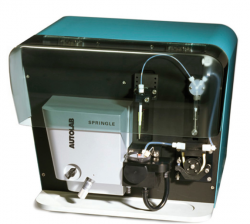
Surface Plasmon Resonance (SPR) Autolab Springle
Research team: Ingénierie des systèmes polymères.
Contact: Joël LYSKAWA.
Studies of interactions between a ligand and a receptor adsorbed on the surface of a metal layer.Technical characteristics:
- The SPR system can be combined with electrochemistry
- Refractive index: 1.26-1.38
- Laser: 670 nm
Surface measurements and imaging (7 instruments)
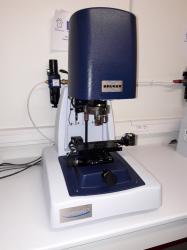
3D optical profiler (ContourGT-K 3D Optical Microscope)
Research team: Métallurgie physique et génie des matériaux.
Contact: Ingrid PRORIOL SERRE.
- Measuring range: 2.3mm² to 30μm.
- Lateral resolution: up to 300 nm
- Resolution in z: below the nm
Atomic Force Microscope Dimension 3100
Research team: Métallurgie physique et génie des matériaux.
Contact: Ingrid PRORIOL SERRE.
Mode: Tapping / contactScanners: 90μm x 90μm x-y images, 6μm in vertical imaging (roughness)
Accessories :
- Anti-vibration table
- Sample holder: standard 150 mm chuck.
- Motorized displacement plate (x, y): probed area 125mm x 100mm.
- MFM mode

Atomic Force Microscope Dimension D1000
Research team: Ingénierie des systèmes polymères.
Contact: Valérie GAUCHER.
AFM Dimension from VeecoImage 90μm x 90μm
Tapping / contact mode
Motorized motion plate
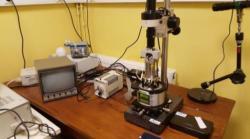
Atomic Force Microscope Multimode
Research team: Ingénierie des systèmes polymères.
Contact: Valérie GAUCHER.
Contact mode
150μm x 150μm image
Atomic Force Microscope Multimode
Research team: Métallurgie physique et génie des matériaux.
Contact: Ingrid PRORIOL SERRE.
AFM Multimode from VeecoTechnical characteristics
- Contact mode
- 150μm x 150μm image
- Vertical scale: 5 μm (roughness)
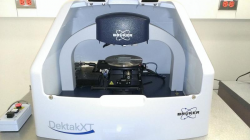
Mechanical profilometer with stylet Bruker
Research team: Ingénierie des systèmes polymères.
Contact: Joël LYSKAWA.
Technical characteristics:
- Possible measurement in a range from 1nm to 1 mm
- 3D cartography
- 2 μm probe
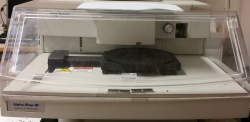
profilometerAlpha-Step IQ de KLA-Tencor
Research team: Ingénierie des systèmes polymères.
Contacts: Séverine BELLAYER, Maude JIMENEZ.
Alpha-Step IQ (2D benchtop surface profiler), HRP 350 series (high resolution surface profiler) provide comprehensive surface metrology analysis and surface topography control solutions to meet the needs of the most demanding surface profiling applications.
Surface treatment (10 instruments)
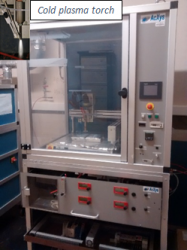
Atmospheric plasma ULS and ULD (Acxys)
Research team: Ingénierie des systèmes polymères.
Contact: Maude JIMENEZ.
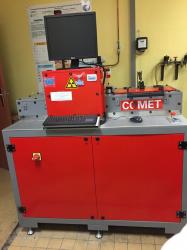
Electron accelerator EB-Lab COMET
Research team: Ingénierie des systèmes polymères.
Contact: Ulrich MASCHKE.
Polymerization / assisted crosslinking, surface treatment
Technical characteristics:
- maximum dimension of the sample: A4x5cm
- depth treatment up to 300μm
- Beam intensity variation and conveyor speed
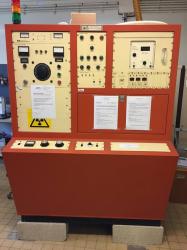
Electron accelerator EB-Labunit ESI
Research team: Ingénierie des systèmes polymères.
Contact: Ulrich MASCHKE.
Polymerization / assisted crosslinking, surface treatment
Technical characteristics:
- maximum dimension of the sample: A5x1cm
- depth treatment up to 200μm
- Beam intensity variation and conveyor speed

low-pressure plasma system
Research teams: Ingénierie des systèmes polymères, Métallurgie physique et génie des matériaux.
Contact: Jean-François BRUN.
Low-pressure plasma system with a 40kHz/100W generator for
- cleaning the surface of most of materials, including the smallest cracks
- activating the surface to increase wettability
Treatment of small samples (a few cm2 or cm3)
Gaz available: air, pure oxygen.
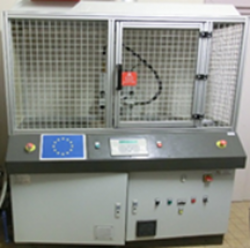
Semi-industrial flaming bench IPROS
Research team: Ingénierie des systèmes polymères.
Contact: Maude JIMENEZ.

Semiautomatic digital screen printing machine, universal model 150 (Dubuit)
Research team: Ingénierie des systèmes polymères.
Contact: Ulrich MASCHKE.
Sample preparation by screen printing, deposition of organic coatingsTechnical characteristics:
- device for glass objects
- marking device for glass bottles
- cadence 1500-3000 cycles / h
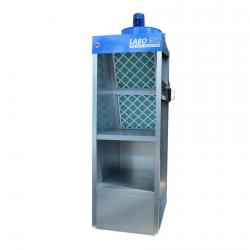
Spray booth (Tricolor industries, Labo600)
Research team: Ingénierie des systèmes polymères.
Contact: Pierre BACHELET.
Worktops 700mm wide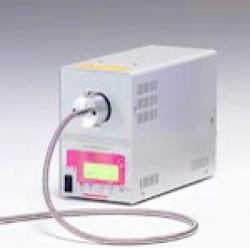
UV lamp Hamamatsu LC8
Research team: Ingénierie des systèmes polymères.
Contact: David FOURNIER.
UV irradiationsTechnical characteristics:
- Mercury xenon lamp 200W
- Optical fiber
- 4500 mW / cm² (365nm)
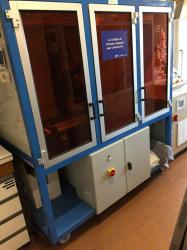
UV-visible irradiation unit Dr. Hönle
Research team: Ingénierie des systèmes polymères.
Contact: Ulrich MASCHKE.
Polymerization / assisted crosslinking, surface treatmentTechnical characteristics:
- maximum dimension of the sample: A4
- Variation of light intensity and conveyor speed
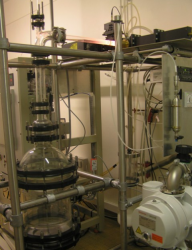
Vacuum plasma
Research team: Ingénierie des systèmes polymères.
Contact: Charafeddine JAMA.
Microwave plasma allowing to deposit different types of precursors (LP-PECVD)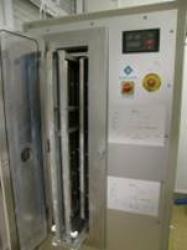
Low pressure cold plasma (Europlasma)
Research team: Ingénierie des systèmes polymères.
Contacts: Maude JIMENEZ, Charafeddine JAMA.
common center of electronic microscopy (1 instrument)
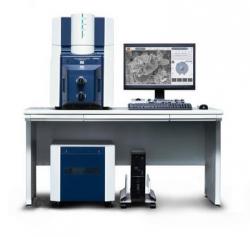
SEM-FlexSem1000
Platform: Electron Microscopy Platform (PMEL).
Contact: Anne-Marie BLANCHENET.
The FLEXSEM 1000 is a compact variable pressure MEB that offers the performance of a conventional SEM.
It is equipped with SE, BSE and EDX detectors
- Thermionic emission: Tungsten filament
- Adjustable acceleration voltage from 1 keV to 20keV
-Resolution with SE sensor: 4nm at 20kV, - Resolution with BSE detector: 5nm at 20kV
- Possibility to work at low pressure from 6 Pa to 100 Pa
- Motorized stage with continuous movements on 5 axes: X, Y, Z, R, T
- Observations of fine, massive, dry, fatty, hydrated samples, without prior preparation
- Possible increase up to x 60,000
Heat treatment (9 instruments)
furnaces (7 instruments)
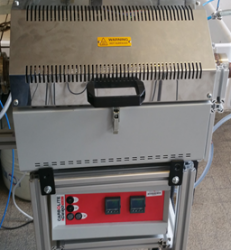
Bi-zone tubular oven (Carboline)
Research team: Ingénierie des systèmes polymères.
Contact: Pierre BACHELET.
T ° C max. 1200 ° C, 2 zones of length 150mm. Work under controlled atmosphere possible.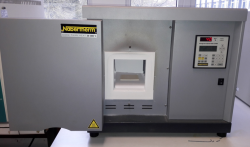
Chamber furnace (1750°C)
Research team: Métallurgie physique et génie des matériaux.
Contacts: Franck BÉCLIN, Matthieu TOUZIN.
glass synthesis and high temperature annealing
Forced air annealing furnace (800 ° C)
Research team: Métallurgie physique et génie des matériaux.
Contacts: Franck BÉCLIN, Matthieu TOUZIN.
Forced air chamber furnace for non-reducing atmosphere annealing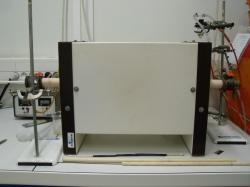
Horizontal tube furnaces under controlled atmosphere (Pyrox VG30 )
Research team: Earth and Planetary Materials.
Contacts: Jannick INGRIN, Adeline MARIN.
Conduct atomic diffusion experiments in minerals and rocks.Oven for annealing (500 - 1300 ° C) under controlled oxygen fugacity conditions for small samples (a few mm)
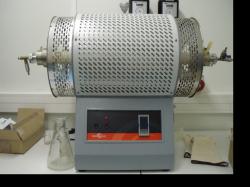
Horizontal tube furnaces under controlled atmosphere (Thermoconcept ROC 50/250/15 )
Research team: Earth and Planetary Materials.
Contacts: Jannick INGRIN, Adeline MARIN.
Conduct atomic diffusion experiments in minerals and rocks.Furnace for annealing (500 - 1300 ° C) under controlled oxygen fugacity conditions for samples of some cm.
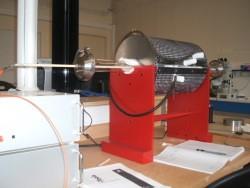
tubular furnace 900 ° C under gas flow
Research team: Earth and Planetary Materials.
Contact: Hugues LEROUX.
annealing furnace under gaseous flow (neutral gas as N2 type, Ar ..) max temperature 900 ° C.
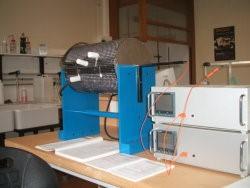
tubular furnace 900°C
Research team: Earth and Planetary Materials.
Contact: Hugues LEROUX.
tubular furnace, under air, max temperature 900 ° C. furnace adapted to long-duration annealing.Ovens (2 instruments)
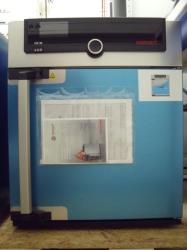
oven (300°C) UN30 Memmert
Research team: Earth and Planetary Materials.
Contact: Corentin LE GUILLOU.
Dedicated in particular to long-term hydrothermal weathering experiments.32 liters, programmable, temperature range 30 to 300 ° C
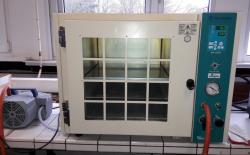
Ovens under vacuum (250°C)
Research team: Métallurgie physique et génie des matériaux.
Contacts: Franck BÉCLIN, Matthieu TOUZIN.
Oven able to work under primary vacuum.Capacity 65 l
Max temperature 250°C
High Pressure Lab (11 instruments)

Diamond anvil cells
Research team: Earth and Planetary Materials.
Contacts: Sébastien MERKEL, Julien CHANTEL.
The diamond anvil cell allows the experimental study of mantle materials and the Earth's core. The sample is compressed between two diamonds having a flat surface with a diameter ranging from 10 to 700 μm. The properties of the sample are then studied by diffraction or spectroscopy. The laboratory has several cells, allowing in-situ experimentation at pressures above the megabar. For temperatures below 1500 K, the sample can be heated using a graphite furnace fitted inside the diamond cell. Samples can also be heated to temperatures of several thousand degrees by focusing on the sample of power lasers (10 to 100W, infra-red). This operation allows the activation of phase transitions with slow kinetics, to relax the constraints within the samples, and to reproduce the conditions of the interior of the planets. The laboratory does not have a laser heating system and we occasionally use assemblies installed in other laboratories or during our in-situ campaigns on large instruments.
Fluorescence and Raman spectroscopy
Research team: Earth and Planetary Materials.
Contacts: Sébastien MERKEL, Julien CHANTEL.
The fluorescence spectrum of the ruby is particularly useful for measuring the pressure applied in a diamond cell. Indeed, the rubies doped with Cr3 + ions emit a spectrum whose lines are shifted with the pressure. Raman spectroscopy probes vibrations in crystals, liquids and glasses. The changes in the spectra induced by the pressure can be interpreted in terms of changes in the arrangement of atoms and the motions of these atoms.
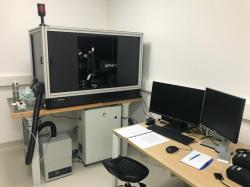
Laser cutting machine
Research team: Earth and Planetary Materials.
Contacts: Julien CHANTEL, Sébastien MERKEL.
Description en Anglais: The system allows for fine preparation of gaskets and samples for diamond anvil cell experiments. Indeed, these experiments require metal drilling for openings with a diameter that can go down to 50 μm. The samples, themselves, of metallic or ceramic nature, have a diameter of between 10 and 30 μm.

Micro digital milling machine
Research team: Earth and Planetary Materials.
Contacts: Julien CHANTEL, Nadège HILAIRET.
This tool allows the production of prototypes or small series of metal or ceramic parts for so-called 'big volume' experiments (piston-cylinder and multi-anvils).

Micro-drill
Research team: Earth and Planetary Materials.
Contacts: Sébastien MERKEL, Julien CHANTEL.
Column precision drill, used for part making for so-called 'big volume' experiments (piston-cylinder and multi-anvils).
Micromanipulator
Research team: Earth and Planetary Materials.
Contacts: Sébastien MERKEL, Julien CHANTEL.
Allows handling of items smaller than 10µm when preparing diamond cell experiments.
Microwave welder under neutral atmosphere
Research team: Earth and Planetary Materials.
Contacts: Julien CHANTEL, Nadège HILAIRET.
Fine welding technique by instant fastening for all metals. Used to hermetically seal the metal capsules of so-called 'big volume' experiments (piston-cylinder and multi-anvils).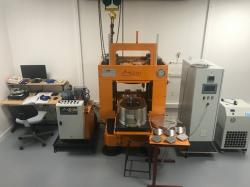
Multianvil Press
Research team: Earth and Planetary Materials.
Contacts: Julien CHANTEL, Nadège HILAIRET.
Ø This device can generate simultaneously pressures up to 26 GPa and temperatures up to 2000°C on millimetric samples.
The applications of multianvil presses are numerous: synthesis of new materials, studies of phase equilibria, melting curves, crystal transformations, measurement of elastic or electrical properties, etc.

Piston-cylinder press
Research team: Earth and Planetary Materials.
Contacts: Nadège HILAIRET, Julien CHANTEL.
This press, with a solid confinement medium, allows experiments at pressures up to 4 GPa and temperatures of 1800 ° C, on samples pluri-millimeter to centimetric. This device contributes to the synthesis of innovative materials, the production of materials with controlled compositions and microstructures, the synthesis of synthetic rocks and the sintering of natural or synthetic rocks.
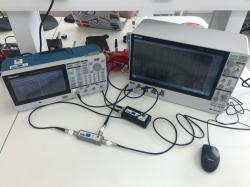
Ultrasonic wave velocity mesurement setup
Research team: Earth and Planetary Materials.
Contacts: Julien CHANTEL, Sébastien MERKEL.
This setup allows the measurement of elastic properties through ultrasonic wave velocity measurements.
The device is adaptable to the multianvil press, to the piston-cylinder press and to the Paris-Edinburgh type torsion module.
It will therefore allow measurements over the pressure range of 1–25 GPa. The setup consists of an arbitrary function generator (AFG31102), a pre-amplifier, a directional bridge (50 Ohm RF bridge 300kHz to 6GHz) and a digital oscilloscope (MSO54).

Wire saw
Research team: Earth and Planetary Materials.
Contacts: Nadège HILAIRET, Julien CHANTEL.
Precision cutting (lower than 100 µm) of metals, ceramics and samples without destruction or modification of the material.
Mechanical / Rheological properties tests (17 instruments)
Mechanical tests for metals (6 instruments)
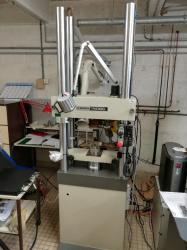
Fatigue machine +/- 50 kN
Research team: Métallurgie physique et génie des matériaux.
Contact: Jean-Bernard VOGT.
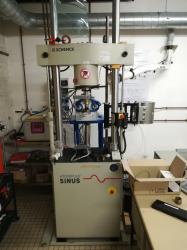
fatigue machine with tubular furnace
Research team: Métallurgie physique et génie des matériaux.
Contact: Jean-Bernard VOGT.
Compression / Traction 250 kN, furnace max 650°C and possibility induction furnace.Fatigue tests on metal test pieces up to 10 mm diameter
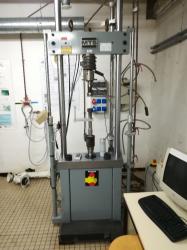
Machine fatigue MTS 100 kN
Research team: Métallurgie physique et génie des matériaux.
Contact: Jean-Bernard VOGT.
Compression / Traction 100 kN with tubular furnace 650 ° C or mechanical test in liquid nitrogenFatigue tests on metal specimen diameter (10 mm) hot or cold
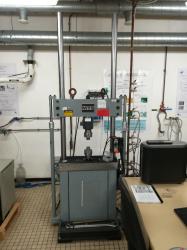
Machine fatigue MTS 25 kN
Research team: Métallurgie physique et génie des matériaux.
Contact: Jean-Bernard VOGT.
Compression / Traction 25 kNFatigue tests on small diameter metal specimen (4mm) and thin thickness (of the order of 0.350 mm)
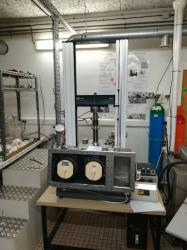
tensile test device +/- 30 kN with +/- 30 kN controlled atmosphere test chamber +/- 30 kN
Research team: Métallurgie physique et génie des matériaux.
Contact: Jean-Bernard VOGT.
Compression / tensile test 30 kNTensile tests or Small Punch Test at temperature up to 500 ° C (heating cord) with control of the oxygen content and moisture content
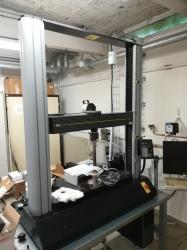
Tensile test device +/- 30kN INSTRON 5567A
Research team: Métallurgie physique et génie des matériaux.
Contact: Jean-Bernard VOGT.
Mechanical tests for polymer (6 instruments)
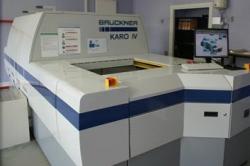
Biaxial stretching KARO IV
Research team: Ingénierie des systèmes polymères.
Contact: Grégory STOCLET.
biaxial stretching KARO IV from BRUCKNER
• Features of the device:
1500N maximum force per axes
Configuration on 2 ovens, capacity up to 250 ° C each
Maximum draw ratio 7 * 7
Sample size 115 x 115 x 2 mm (LxWxD)
Drawing speed 1 to 500mm / s (moving constant)
• Use in research themes:
Study of the mechanical behavior of stress complexes
Simulations of industrial manufacturing processes (blowing, bi-drawing ...)
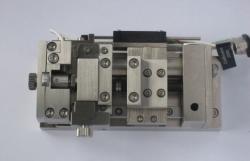
Deformation modulus under AFM / SEM (DEBEN)
Research team: Ingénierie des systèmes polymères.
Contact: Sophie BARRAU.
Instrument for in-situ study of polymer deformation:
- Maximum force 2kN
- Speed range: 0.03mm / min to 0.5mm / min
- Maximum specimen size 35 x 15 x 5 mm
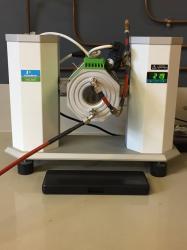
DMA 8000 (Perkin-Elmer)
Research team: Ingénierie des systèmes polymères.
Contact: Ulrich MASCHKE.
Analysis of the mechanical dynamic properties of a sample by temperature variation and frequency.Technical characteristics:
- possible measures in a dry environment and in solution
- temperature range -150 ° C - + 400 ° C
- 4 geometries available (cantilever bending, 3-point bending, shearing, extension)
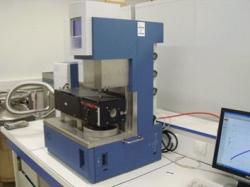
Dynamic Mechanical Analysis (DMA)
Research team: Ingénierie des systèmes polymères.
Contact: Sophie BARRAU.
RSA 3 from TA Instruments
Features of the device:
tension / compression on film or 3-point bending
temperature range -150 to 500 ° C
frequency range 10-3 to 102 Hz
Use in research themes: measurement of the viscoelastic properties of polymers in tension
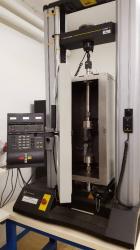
Uniaxial traction
Research team: Ingénierie des systèmes polymères.
Contacts: Valérie GAUCHER, Adeline MARIN.
4466 traction bench from INSTRON
Features of the device:
Maximum force 10 kN
thermal enclosure up to 250 ° C
Use in research themes: measurement of the mechanical properties of polymers
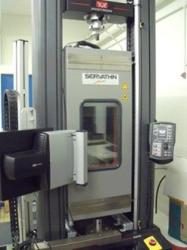
Uniaxial traction with climatic chamber
Research team: Ingénierie des systèmes polymères.
Contacts: Valérie GAUCHER, Adeline MARIN.
• 5966 traction bench from INSTRON• Features of the device:
Maximum force 1 kN
Enclosure controlled in temperature and hygrometry
temperature -40 to 250 ° C
hygrometry 20 to 98% (from 20 to 90 ° C)
AVE non-contact volume measurement system
• Use in research themes: measurement of the mechanical properties of polymers as a function of temperature and hygrometry
Micro-indenters (2 instruments)
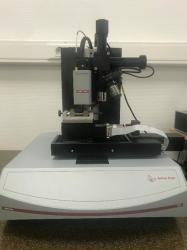
BioIndentor
Research team: Ingénierie des systèmes polymères.
Contact: Valérie GAUCHER.
Indenter for soft materials:
- Measuring range: 10kPa at GPa
- Ruby ball indenters diam 500µm
- indentor Berkovich
- Maximum force 20 mN
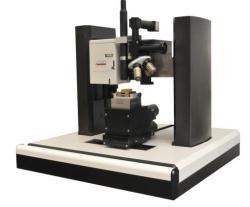
Micro-indenter MHT CSM Instruments
Research team: Métallurgie physique et génie des matériaux.
Contact: Matthieu TOUZIN.
- Instrumented indentation (simultaneous recording of force and displacement) for loads ranging from 0.05 to 10 N; not instrumented beyond (up to 30 N)
- Motorized X-Y stage (positioning
- Coupled optical observation
- Vickers type diamond indenter
- Heated sample plate (up to 450 ° C)
rheometers (2 instruments)
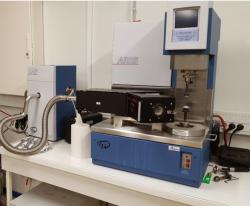
rheometer ARES
Research team: Ingénierie des systèmes polymères.
Contact: Sophie BARRAU.
plate twist, melt rheology on parallel plates
temperature range -150 to 500 ° C
frequency range 10-3 to 102 Hz
Use in research themes:
Measurements of the viscoelastic properties of torsional polymers
Viscosity measurements
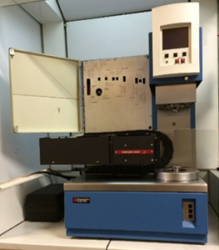
Rotary Rheometer
Research team: Ingénierie des systèmes polymères.
Contact: Pierre BACHELET.
Rotary Rheometer (Rheometric Scientific, ARES)
Ambient measurement up to 500 ° C
Measurement of viscosity, deformation and swelling rate of intumescent materials
viscometry (1 instrument)
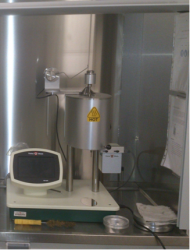
Melt Flow Indexer (MFI)
Research team: Ingénierie des systèmes polymères.
Contact: Pierre BACHELET.
MFI measurement at 190 ° C and 230 ° C.Optical diffusion (2 instruments)
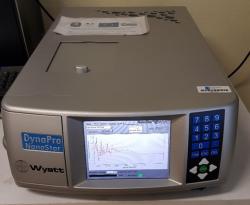
Diffusion of light DLS DynaPro Nanostar Whyatt
Research team: Ingénierie des systèmes polymères.
Contact: Aurélie MALFAIT.
Detection of nanometric particles by dynamic light scattering. Hydrodynamic radius measurementTechnical characteristics:
- Wavelength 658 nm
- Angle of analysis: 90 °
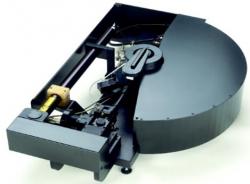
Diffusion of light, Goniometer ALV/CGS-3 Compact
Research team: Ingénierie des systèmes polymères.
Contacts: David FOURNIER, Aurélie MALFAIT.
Static light scattering (SLS) and dynamic (DLS) analysis of particles / (macro) molecules in solutionTechnical characteristics:
- Angular detection from 17 ° to 150 °
- Angular resolution: 0.025 °
- HeNe Laser (632.8 nm, 22 mW)
Optical microscopy (5 instruments)
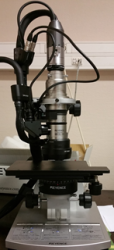
3D optical microscope (Keyence)
Research team: Ingénierie des systèmes polymères.
Contact: Séverine BELLAYER.
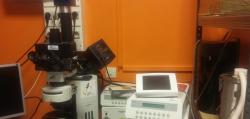
Bench of optical and electro-optical measurements
Research team: Ingénierie des systèmes polymères.
Contact: Corinne BINET.
Optical measurements:Polarizing optical microscopes
Temperature regulation:
Linkam heating plates with liquid nitrogen cooling (-180 ° C to 350 ° C).
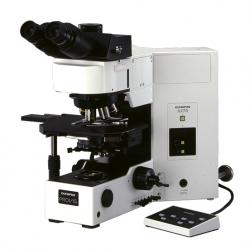
Optical microscope :Olympus BX70
Research team: Staff.
Contact: Anne-Marie BLANCHENET.
Reflected and transmitted light, camera,polarizer, DIC
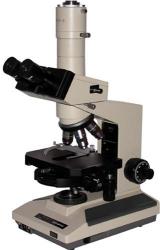
Optical Microscope Olympus BH2
Research team: Staff.
Contact: Anne-Marie BLANCHENET.
Optical microscope with transmitted light and polarizer
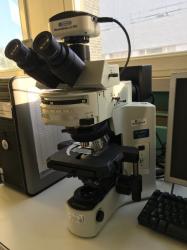
Optical microscope Olympus modèle BX41,
Research team: Ingénierie des systèmes polymères.
transmission or reflection3 objectives (X5, X20, X50)
spatial resolution: at best a few microns
3,3RTV color digital camera
software acquisition and image processing
Physical and physicochemical analyzes of the material (13 instruments)
Electrical, thermoelectric and piezoelectric properties (8 instruments)
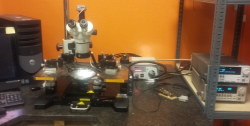
Electrical measuring bench
Research team: Ingénierie des systèmes polymères.
Contacts: Jean-François BRUN, Jean-François TAHON.
4-point measurement system (SUSS MICROTEC EP6) coupled to Keithley electrical measuring instruments (2635 and 2400 flowmeter, DC and AC 6221 current source, 218C nanovolometer)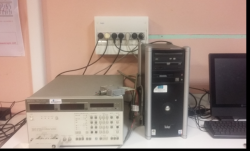
impedance bridge
Research team: Ingénierie des systèmes polymères.
Contact: Corinne BINET.
Impedance bridge, Hewlett Packard 4192A, (5 hz to 13Mhz).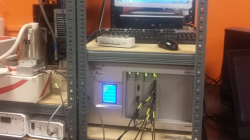
impedance bridge SOLARTRON
Research team: Ingénierie des systèmes polymères.
Contact: Corinne BINET.
Impedance bridge, SOLARTRON, model 2100A, (100μhz to 1Mhz)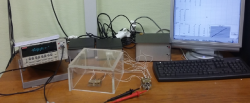
Measuring bench of the Seebeck coefficient
Research team: Ingénierie des systèmes polymères.
Contacts: Jean-François BRUN, Jean-François TAHON.
Seebeck coefficient bench for pellets and thin films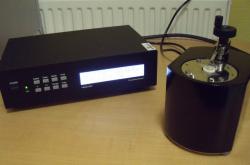
piezometer PM200
Research team: Ingénierie des systèmes polymères.
Contact: Sophie BARRAU.
• Features of the device:
Static force of 10N
• Use in research themes: measurement of the piezoelectric coefficient d33 of polymer films
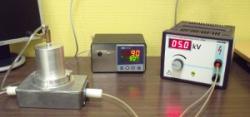
polarizer
Research team: Ingénierie des systèmes polymères.
Contact: Sophie BARRAU.
Voltage range 0 to 25kV
Ambient temperature range at 100 ° C
Use in research themes: polarization of polymer film

Potentiostat / Galvanostat Autolab PGSTAT 302N
Research team: Ingénierie des systèmes polymères.
Contact: Joël LYSKAWA.
Technical characteristics:
- Range of potential: +/- 10 V
- Compliance: +/- 30 V
- Maximum current: +/- 2 A
- Current range: 1 A to 10 nA
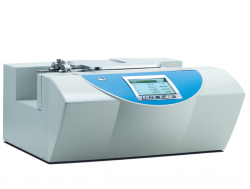
Thin film analyzer
Research team: Ingénierie des systèmes polymères.
Contacts: Jean-François BRUN, Jean-François TAHON.
Thermoelectric measurement bench: measures thermal conductivity, electrical conductivity and Seebeck coefficient on thin layers and simultaneous
Thermal conductivity (3 instruments)
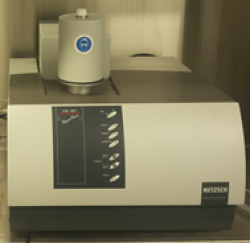
Laser Flash Analyzer (Netzsch, LFA 457)
Research team: Ingénierie des systèmes polymères.
Contact: Pierre BACHELET.
Determination of the thermal diffusivity of the ambient up to 500 ° C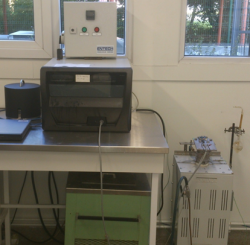
Thermal Conductivity Meter (Hot Disk, TPS2500S)
Research team: Ingénierie des systèmes polymères.
Contact: Pierre BACHELET.
Measurable materials: solids, liquids, powders and pastes, thermal conductivity (0.005 to 1800 W / m.K), thermal diffusivity (0.01 to 1200 mm² / s). Ambient measurements up to 800 ° C.
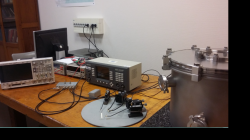
Thermal Conductivity Thin Film Measurement Bench
Research team: Ingénierie des systèmes polymères.
Contacts: Jean-François BRUN, Jean-François TAHON.
Synchronous detection system, AMETEK 7270 with vacuum pumping bench allowing thermal conductivity measurements by the 3ω method
Optical bench for emissivity measurements
Research team: Ingénierie des systèmes polymères.
Contacts: Johan SARAZIN, Tsilla BENSABATH-PEREZ.
The optical bench allows to measure material emissivity between 7500 and 400 cm-1.
Measurements can be done either at room temperature (total emissivity by an integrating sphere) or according to the temperature up to 800°C (directional emissivity).
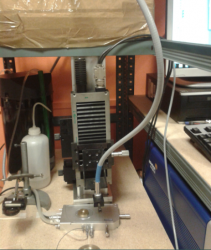
UV-visible irradiation bench
Research team: Ingénierie des systèmes polymères.
Contact: Corinne BINET.
200W arc light source Mercury Xenon (LOT-ORIEL).Resistance and Reaction to Fire (14 instruments)
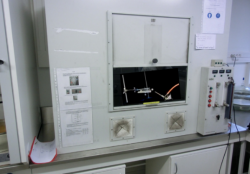
Cabine UL94 (FTT)
Research team: Ingénierie des systèmes polymères.
Contact: Pierre BACHELET.
The purpose of this test is to evaluate the ability of the material to self-extinguish after contact with a pilot flame (test piece placed horizontally or vertically), by measuring the speed and the burning time. ISO1210 standard.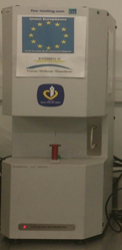
FAA Micro Calorimeter (FTT)
Research team: Ingénierie des systèmes polymères.
Contact: Pierre BACHELET.
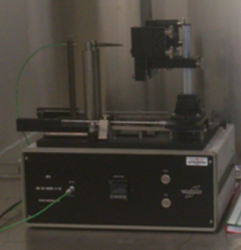
Glow Wire Test (Wazau)
Contact: Pierre BACHELET.
Determination of GWFI and GWIT (max T ° C 960 °C). IEC60695-2-10, ASTM D6194, UL 746A.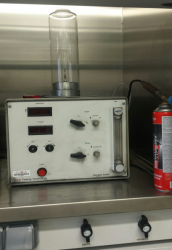
Indice Limite d’Oxygène (FTT)
Research team: Ingénierie des systèmes polymères.
Contact: Pierre BACHELET.
Détermination du LOI selon la norme ISO4589-2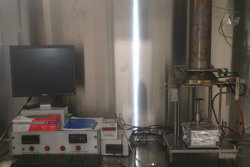
Mass Loss Calorimeter (FTT)
Research team: Ingénierie des systèmes polymères.
Contact: Pierre BACHELET.
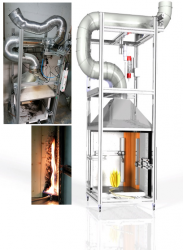
Mini Single Burning Item Test (EN13823) small-scale fire test benches
Research team: Ingénierie des systèmes polymères.
Contact: Pierre BACHELET.
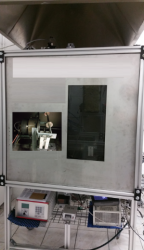
NBS smoke density chamber
Research team: Ingénierie des systèmes polymères.
Contact: Pierre BACHELET.
Measurement of the specific optical density of the smoke generated by the combustion of samples exposed to a radiative heat source of 25 or 50kW / m², with or without a pilot flame. Dimensions samples (73x73mm, thickness 25mm max). Railway (ISO5659) and aeronautical (ASTM E 662) tests.
Small Fire Test Scales Mini Jetfire Test (ISO22899-120007)
Research team: Ingénierie des systèmes polymères.
Contact: Pierre BACHELET.
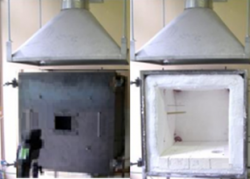
Small scale fire resistance furnaces.
Research team: Ingénierie des systèmes polymères.
Contact: Pierre BACHELET.
1 oven for 280x280mm samples equipped with a burner of 35kW and 1 oven for samples of 100x100mm, equipped with two burners of 20kW and a porthole to visualize the material in the furnace.
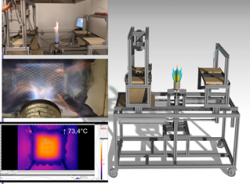
Small-scale fire test benches Type ISO2685 horizontal
Research team: Ingénierie des systèmes polymères.
Contact: Pierre BACHELET.
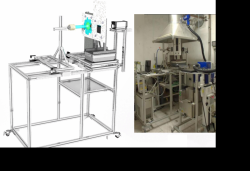
Small-scale fire test benches type ISO2685 vertical
Research team: Ingénierie des systèmes polymères.
Contact: Pierre BACHELET.
120x120mm samples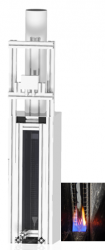
Small-scale fire test benches type NF EN 50399
Research team: Ingénierie des systèmes polymères.
Contact: Pierre BACHELET.
Fire behavior of cable harnesses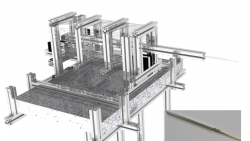
Soot sampling bench in a flame
Research team: Ingénierie des systèmes polymères.
Contact: Pierre BACHELET.
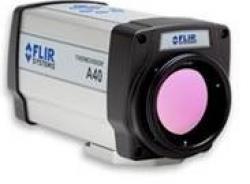
Thermal cameras (Flir A40 and X6540sc)
Research team: Ingénierie des systèmes polymères.
Contact: Pierre BACHELET.
The Flir X6540sc camera is equipped with filters to visualize the flame contours but also to measure the temperature of a surface impacted by a flame by measuring through the flame.RX platform (2 instruments)
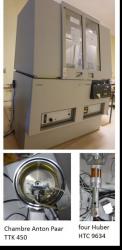
X-ray diffractometer on powders, X'Pert Pro (Panalytical)
Research team: Matériaux moléculaires et thérapeutiques.
Platform: Plateau d’analyses par diffraction des Rayons X.
Contacts: Mathieu GUERAIN, Florence DANEDE.
Technical characteristics
- Copper tube
- Transmission measurements on samples conditioned in capillaries with the possibility of varying the temperature from ambient to 300 ° C (Huber oven)
- Reflection measurements on platelets with the possibility of varying the temperature from -150 ° C to 400 ° C (room Anton Paar TTK 450)
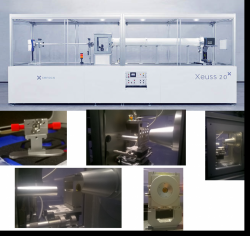
X-Ray Diffusion/Diffraction bench, Xeuss2.0 (Xenocs)
Research team: Ingénierie des systèmes polymères.
Platform: Plateau d’analyses par diffraction des Rayons X.
Contacts: Jean-François TAHON, Grégory STOCLET.
SAXS and WAXS Small and Large Angle Bench with Cu Microsource XENOCS with a CCD detector PILATUS 200K.
Specificities and equipments :
- Transmission measurements with sample gates for solids, powders, capillaries and liquids with the possibility of varying the temperature from -180 ° C to 350 ° C.
- The instrument is equipped to perform GiSAXS / GiWAXS thin-layer measurements.
Sample preparation for electron microscopy (17 instruments)
Cutting and sampling (3 instruments)
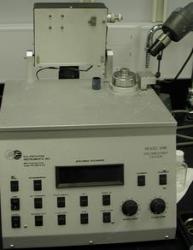
Dimpler
Platform: Electron Microscopy Platform (PMEL).
Contact: Anne-Marie BLANCHENET.
he Dimpler is a precision instrument used for grinding circular dimples in the surface of materials. The Dimpler The sample is placed on a horizontal plane rotating around a vertical axis and a grinding wheel rotating
around a horizontal axis. The dimple technique produces with minimal damage a thin region
in the disk (thickness less than 50 μm) while leaving a relatively thick support border surrounding the thin
region and thus providing a very robust sample. A chemical or ionic thinning then makes it possible
to obtain large transparent areas.
Applications: Many materials can be dimpled: ceramics, metals, minerals, glasses, minerals, multi-phase materials,
composites etc.
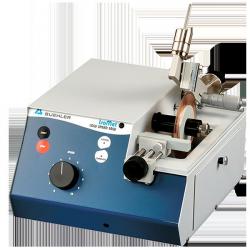
ISOMET LOW SPEED BUEHLER
Platform: Electron Microscopy Platform (PMEL).
Contact: Anne-Marie BLANCHENET.
Small slow speed chainsaw for cutting materials with a diamond disc
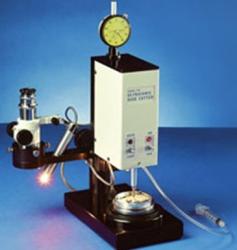
Ultrasonic Cutter
Platform: Electron Microscopy Platform (PMEL).
Contact: Anne-Marie BLANCHENET.
Equipment for ultrasonically cutting discs 3 mm in diameter. Applications: hard metals, mineral ceramics
ionic polishing (4 instruments)
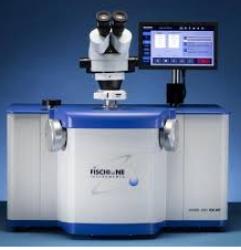
Ion polisher
Platform: Electron Microscopy Platform (PMEL).
Sample surface polishing system with 2 independent and independently adjustable voltage guns (between 100 and 1000v) at angles (0 and 10 °). Ability to work at low temperatures for fragile materials. Application: Good surface quality for SEM, EBSD ... Planar polishing and cross section
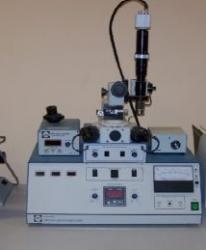
Ion polishing system PIPSI
Platform: Electron Microscopy Platform (PMEL).
Contact: Anne-Marie BLANCHENET.
PIPSI is a ion polishing machine that works by ion thinning at a very small angle (between 0 and 10 °). The low spray angles have the advantage of minimizing the damage caused by irradiation and beam heating while at the same time producing samples with electron-transparent areas with minimal artefacts. Ability to work at low temperatures.
Applications:
TEM preparation for many materials: ceramics, metals, minerals ...
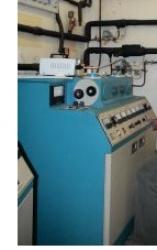
Ion polishing system GATAN DUO MILL
Platform: Electron Microscopy Platform (PMEL).
Contact: Anne-Marie BLANCHENET.
The GATAN DUO MILL 600 DIF model is used for the final stage of sample preparation for transmission electron microscopy. The sample is thinned on both sides by means of an argon ion beam.
The acceleration voltage, the ionic current and the angle of incidence varying from 0 to 40 ° can be selected according to the properties of the sample material. Pre-thinned samples are bombarded until perforation or until the sample becomes electron-transparent. Ability to work at low temperatures for fragile materials.
Applications:
Thin slimming and large area of thinning for ceramics, metals, minerals
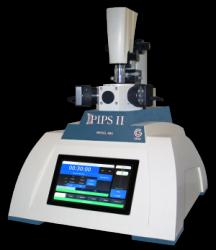
Precision Polishing system PIPSII
Platform: Electron Microscopy Platform (PMEL).
Contact: Anne-Marie BLANCHENET.
This is a second-generation of ionic polishing system for the preparation of samples for the MET.
Each gun can work from 0.1-8 kV with an inclination angle of ± 10 ° and are motorized.
The PIPS is equipped with a displacement plate in X and Y of the sample for precise positioning of the target
area. The system is also equipped with a cold module to thin temperature sensitive materials.
IT is equipped with a Zoom digital microscope with a computer control system of Digital Micrograph
for in situ observation of sample.
Application:
Cleaning FIB lamella
Micro and ultra-microtome (3 instruments)
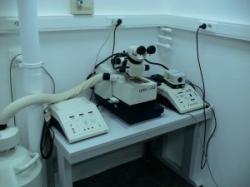
Cryo ultra microtome
Platform: Electron Microscopy Platform (PMEL).
Contact: Anne-Marie BLANCHENET.
Equipment for making ultrafine cuts at low temperatures using diamond knives.
Applications: Polymer sections for TEM, powder dispersed in a resin
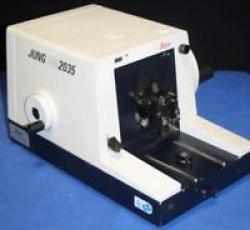
Microtome
Platform: Electron Microscopy Platform (PMEL).
Contact: Anne-Marie BLANCHENET.
Equipment allowing to make cuts of order 5 to 120μm at room temperature. Application: Polymers
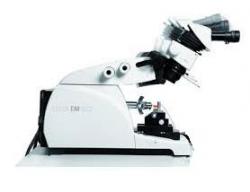
Ultra microtome
Platform: Electron Microscopy Platform (PMEL).
Contact: Anne-Marie BLANCHENET.
Equipment for making ultrafine sections at room temperature with diamond knives. Applications: Polymer sections for TEM, powder dispersed in a resin
Polishing (3 instruments)
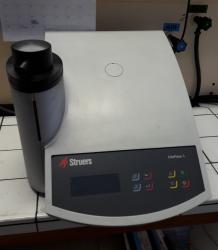
hot enrobing press
Research team: Métallurgie physique et génie des matériaux.
Contacts: Damien CRETON, Matthieu TOUZIN.
Hot enrobing of sample in conductive or non-conductive resinsCoating diameter 30mm,
Enrobing parameters
- Pressure from 50 to 350 bar in increments of 25 bar
- Heating time From 1 to 15 minutes. in steps of 0.5 minutes.
- Heating temperature 80-180 ° C in increments of 5 ° C
- Cooling time From 1 to 15 min in steps of 0.5 min.
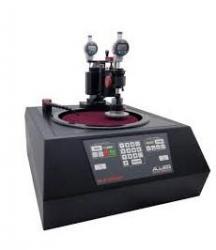
Semi-automatic polisher:Multiprep
Contacts: Anne-Marie BLANCHENET, Maya MARINOVA.
The MULTIPREP allows the precise polishing of samples to be analyzed by microscopic (optical, SEM, MET etc.).
Possibility of parallel polishing, angle polishing. Two micrometers allow precise adjustments of the tilt
of the sample relative to the abrasive plane
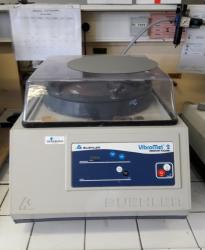
Vibration polisher VibroMet 2 BUEHLER
Research team: Métallurgie physique et génie des matériaux.
Contact: Damien CRETON.
Finishing polishing with colloidal silica on a wide range of materials, especially for EBSD applications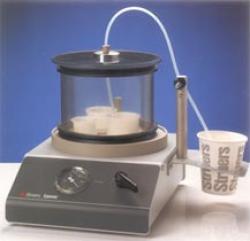
Platform: Electron Microscopy Platform (PMEL).
Contact: Anne-Marie BLANCHENET.
Vacuum impregnation system, specially designed for impregnated of porous materials.
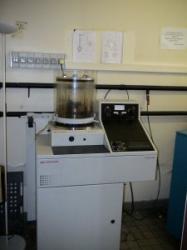
Carbon coater machine
Platform: Electron Microscopy Platform (PMEL).
Contact: Anne-Marie BLANCHENET.
To avoid the charge of non-conductive samples, the coated machine deposits
carbon on the sample for MEB or MET observation
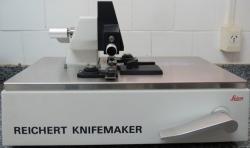
Knifemaker
Platform: Electron Microscopy Platform (PMEL).
Contact: Anne-Marie BLANCHENET.
Allows you to make glass knives for ultra microtome cuts

Metals coated machine: Precision Etching and Coating System (PECS)
Platform: Electron Microscopy Platform (PMEL).
Contact: Anne-Marie BLANCHENET.
PECS deposits extremely thin metal coatings on samples for both SEM and TEM observations.
The target material is bombarded by two argon ion beams accelerated to about 8 kV.
The ejected target material then strikes the surface of the sample which is rotated at different angles
during the coating process. The thickness of the deposit can be controlled.
Application: Coated of chrome deposit, carbon, platinum ...
Separative techniques (9 instruments)
centrifuges (2 instruments)
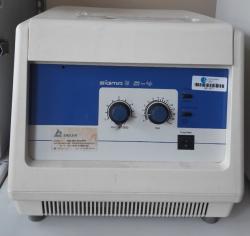
Centrifuge Sigma 2-4
Research team: Ingénierie des systèmes polymères.
Contact: Stéphanie DEGOUTIN.
Supports 1 or 4 tubes

Centrifuge Sigma 6-16HS
Research team: Ingénierie des systèmes polymères.
Contact: David FOURNIER.
Separation of the constituents of a mixture according to their difference in density by subjecting them to a centrifugal forceTechnical characteristics:
- Working temperature: 4 to 70 ° C
- Rotation speed up to 13,500 rpm
chromatography (5 instruments)
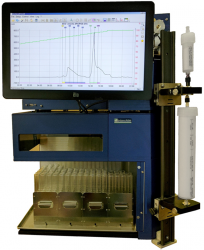
Flash Chromatography : Puriflash Interchim 430
Research team: Ingénierie des systèmes polymères.
Contact: Jonathan POTIER.
Automatic purification of reaction crude.Technical characteristics:
- UV and / or ELSD detection
- Programming via the computer interface
- Ability to load up to 20g of product to purify
- Silica cartridges with two different particle sizes (15 and 30 μm)
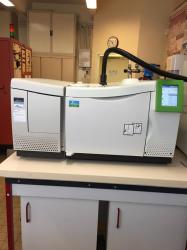
Gas Chromatography / Mass Spectroscopy
Research team: Ingénierie des systèmes polymères.
Contact: Ulrich MASCHKE.
GC Clarus 680 couplée à MS Clarus 600T (Perkin-Elmer)
Separation and qualitative and quantitative identification of products of organic origin
Technical characteristics:
- GC Elite-5HT column, length: 30 m, internal diameter: 0.25 mm
- MS (electronic ionization) detection up to 1166 m / z
- ion separator by quadrupole filter
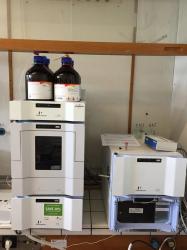
High performance liquid chromatography (HPLC) Flexar model (Perkin-Elmer)
Research team: Ingénierie des systèmes polymères.
Contact: Ulrich MASCHKE.
Technical characteristics:
- simultaneous multi-wavelength detection
- autosampler
- 5 solvents max.
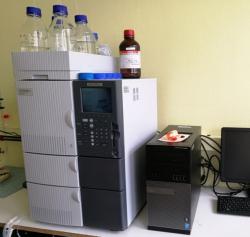
HPLC LC-2010 HT SHIMADZU
Research team: Ingénierie des systèmes polymères.
Contact: Jean-Noël STAELENS.
Technical characteristics :
- Non-thermostatic sample changer, for 2 mL vials
- Quaternary pump, allowing mixtures in low pressure gradient, or isocratic work.
- Single column compartment, thermostatic
- UV detector 190 nm at 950nm, 8 wavelengths.
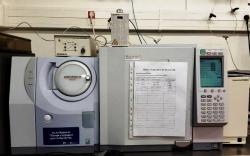
Pyrolyzer coupled GC-MS (Shimadzu)
Research team: Ingénierie des systèmes polymères.
Contact: Pierre BACHELET.
Pyrolysis up to 800 ° C.
SEC platform (2 instruments)
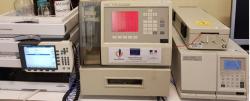
SEC Chain Agilent and Détector RI WATERS (DMF)
Research team: Ingénierie des systèmes polymères.
Contact: Aurélie MALFAIT.
Technical characteristics:
- Analyzes in the DMF
- Masses between 1000 and 600 000 g / mol
- Relative mass detection with calibration curve
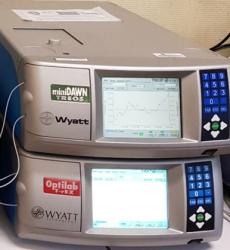
SEC Chain WATERS with détector RI et MALLS WYATT (THF)
Research team: Ingénierie des systèmes polymères.
Contact: Aurélie MALFAIT.
Technical characteristics:
- Analysis in THF
- Masses between 1000 and 600 000g / mol
- Dn / dc measurement according to the solvent
- Relative mass detection with calibration curve or absolute mass with dynamic light scattering detector (MALLS) and dn / dc mandatory.
spectroscopy (15 instruments)
Infra red spectrometers (4 instruments)
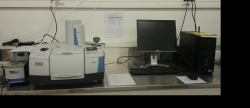
FTIR spectrometer (Thermofisher, IS50)
Research team: Ingénierie des systèmes polymères.
Contact: Pierre BACHELET.
Equipped with ATR and ATR heating module, it can work on liquids or solids. The heating ATR can allow the follow-up of polymerization reactions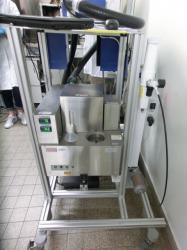
FTIR with gas cell (ThermoFisher, Antaris IGS)
Contact: Pierre BACHELET.
Capable of simultaneously analyzing multiple gas species, offering high calibration and stability performance, as well as high-speed data acquisition. Equipped with a heated transfer line, the device is mobile and can perform measurements on different tests.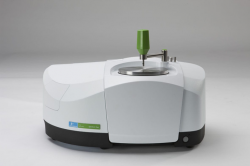
Spectrum Two (Perkin Elmer) + press (Specac)
Research team: Ingénierie des systèmes polymères.
Contact: Stéphanie DEGOUTIN.
Analyze It All / Know It All software (Bio-Rad) with spectral libraries for interpretation
Heated platen press + pelletizer for
the development of KBr pellets
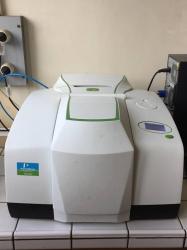
Transformed infrared spectrophotometer of Fourier (FTIR) model Frontier (Perkin-Elmer)
Research team: Ingénierie des systèmes polymères.
Contact: Ulrich MASCHKE.
Analysis of the vibrational transitions of the chemical bonds according to the wave numberTechnical characteristics:
- transmission mode and ATR mode
- range of wave numbers from 4000cm-1 to 400cm-1
- Press for the preparation of KBr pellets
Raman and Fluorescence Spectrometers (4 instruments)

Fluorescence and Raman spectroscopy
Research team: Earth and Planetary Materials.
Contacts: Sébastien MERKEL, Julien CHANTEL.
The fluorescence spectrum of the ruby is particularly useful for measuring the pressure applied in a diamond cell. Indeed, the rubies doped with Cr3 + ions emit a spectrum whose lines are shifted with the pressure. Raman spectroscopy probes vibrations in crystals, liquids and glasses. The changes in the spectra induced by the pressure can be interpreted in terms of changes in the arrangement of atoms and the motions of these atoms.
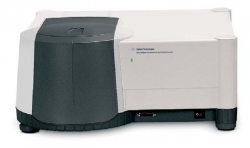
Fluorescence Spectrophotometer Cary Eclipse
Research team: Ingénierie des systèmes polymères.
Contact: David FOURNIER.
Fast recording of absorption and emission spectra of FluorescenceTechnical characteristics:
- Source: pulsed xenon lamp
- Scan speed up to 24,000 nm / min
- Temperature studies: 10-100 ° C
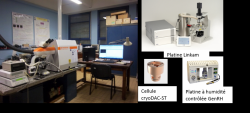
Raman µspectrometer Renishaw InVia , suitable for medium-frequency studies (150-1800 cm-1)
Research team: Matériaux moléculaires et thérapeutiques.
Contacts: Yannick GUINET, Alain HEDOUX, Laurent PACCOU.
Analysis of the dynamics of glass-forming molecular materials in their amorphous and crystalline states, mechanisms of phase transformation, and stabilization of amorphous states of materials of therapeutic interest (small molecules, proteins) by excipients- lasers lmbda = 514 nm and 785 nm
- Platinum LinKam Scientific Instrument see part Heat treatment
- XYZ Platinum for cartography
- Anvil cell diamond Chervin type pressure generator 40 GPa
- CryoDAC-ST (Alamax Easy lab) cryoDAC-ST anvils cell pressure 15 GPa max and cryostat ST500b (Janis) temperature control from 3.5K to 475K.
- Humidity Controlled Platinum GenRH (Surface Measurement Systems)
- HR from 1 to 98% accuracy 0.8%
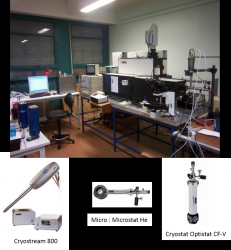
Raman Spectrometer XY Dilor, suitable for Low Frequency Macro Studies (5-500 cm-1)
Research team: Matériaux moléculaires et thérapeutiques.
Contacts: Alain HEDOUX, Yannick GUINET, Laurent PACCOU.
Accessories
- Macro Output: Cryostat Optistat CF-V (Oxford Instrument) Temperature Control 500K to 4.2K
- Macro output: Cryostream 800 (Oxford Instrument) temperature control 500K to 80K with dry nitrogen flow.
- Micro Output: Microstat He (Oxford Instrument) temperature control 500K to 5K
UV spectrometers (6 instruments)
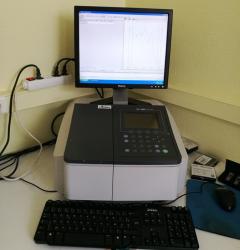
Spectrometer UV 1800 SHIMADZU
Research team: Ingénierie des systèmes polymères.
Contact: Jean-Noël STAELENS.
Technical characteristics :
- Double-beam, monochromator Czerny-Turner
- Spectral range from 190 to 1100 nm
- Photometric range from 0 to 4 Abs
- Parasite light = 0.02% T
- Resolution of 1 nm (190 to 1100 nm)
- Scan speed: 3000 nm / min. at 2 nm / min.
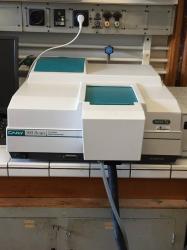
Spectrophotometer UV-Visible CARY 100 (Agilent)
Research team: Ingénierie des systèmes polymères.
Contact: Ulrich MASCHKE.
Analysis of the spectroscopic properties of a sample as a function of wavelengthTechnical characteristics:
- dual beam spectrophotometer
- wavelength range from 200nm to 900nm
- Peltier temperature controller
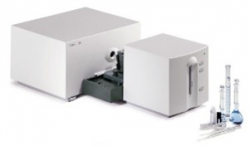
spectrophotometer UV/vis Agilent 8453
Research team: Ingénierie des systèmes polymères.
Contact: David FOURNIER.
Fast recording of UV / Vis spectraTechnical characteristics:
- Sources: diode array
- Scan speed: 190 - 1100 nm in 1.5 seconds
- Temperature studies: 10-100 ° C
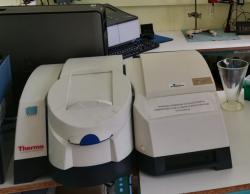
UV Spectrometer Evolution 300 NICOLET
Research team: Ingénierie des systèmes polymères.
Contact: Jean-Noël STAELENS.
Technical characteristics :
- Bandwidth variable from 0.2 to 4nm
- Double beam
- Photodiode detector

UV-visible spectrometer
Research team: Ingénierie des systèmes polymères.
Contact: Corinne BINET.
Optical fiber UV-visible spectrometer (USB200), OCEAN OPTICS, with DH-2000 source (200nm to 900nm)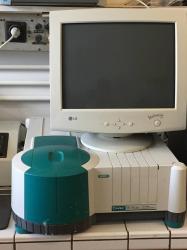
UV-visible Spectrophotometer CARY 50 (Agilent)
Research team: Ingénierie des systèmes polymères.
Contact: Ulrich MASCHKE.
Analysis of the spectroscopic properties of a sample as a function of wavelengthTechnical characteristics:
- single beam spectrophotometer
- wavelength range from 200nm to 900nm
- Peltier temperature controller
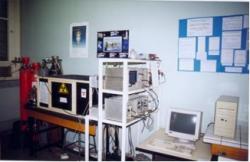
Mössbauer Spectrometry
Research team: Métallurgie physique et génie des matériaux.
Contact: Catherine CORDIER.
Devices
- 57Co sources for the study of alloys containing iron;
- 1 spectrometer for measurements in ambient transmission;
- 1 spectrometer for reflection measurements at ambient temperature:
in CEMS mode - 0.2 μm;
in CXMS mode - 2 μm.
Possible Mössbauer studies
- Identification and determination of phases, determination of their chemical composition;
- Oxidation state of iron;
- Local atomic order and local symmetry;
- Properties: magnetic resolution, indication on charge transfer.
Analyzable materials
- Powder, solid, sheet or coating on solid;
- Nature: Steels (with nitrogen) coated (or not), minerals, catalysts, semiconductors.
Thermal analyzes (20 instruments)
Differential scanning calorimeters (from -180 ° C up to 1500 ° C) (11 instruments)
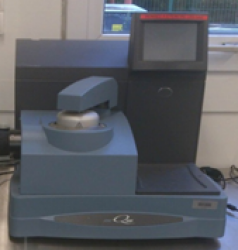
differential scanning calorimeter TA Q100
Research team: Ingénierie des systèmes polymères.
Contacts: Pierre BACHELET, Johan SARAZIN.
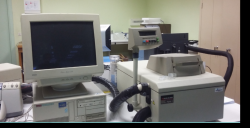
Differential scanning calorimetry
Research team: Ingénierie des systèmes polymères.
Contact: Jean-François TAHON.
DSC with power compensation, PERKIN ELMER, (-180 ° C to 400 ° C).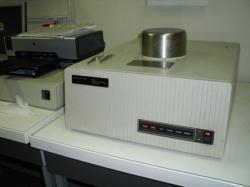
Differential scanning calorimetry DSC7
Research team: Ingénierie des systèmes polymères.
Contact: Adeline MARIN.
Features of the device:ambient temperature range at 500 ° C
Under nitrogen
Use in research themes: thermal analysis of polymers
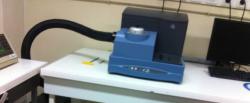
Differential scanning calorimetry Q20
Research team: Ingénierie des systèmes polymères.
Contact: Grégory STOCLET.
Features of the device:temperature range -80 to 500 ° C
Under nitrogen
Use in research themes: thermal analysis of polymers
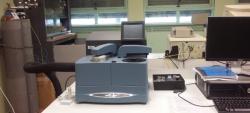
Differential scanning calorimetry Q2000
Research team: Ingénierie des systèmes polymères.
Contact: Jean-François TAHON.
DSC modulated heat flux, TA instrument, Q2000, (-90 ° to 400 ° C).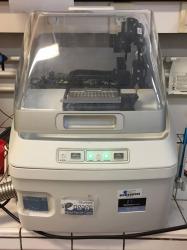
DSC 8000 (Perkin-Elmer)
Research team: Ingénierie des systèmes polymères.
Contact: Ulrich MASCHKE.
Technical characteristics:
- autosampler
- temperature range -80 ° C - + 300 ° C
- photocalorimetric equipment
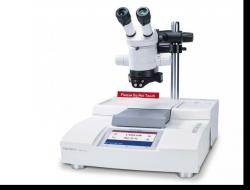
Flash DSC2+ (Mettler Toledo)
Research team: Métallurgie physique et génie des matériaux.
Contact: Marie-Noëlle Avettand-Fénoël.
Heating rate: 30 K / s to 40000 K/s
Cooling speed in absolute value up to 4000 K/s
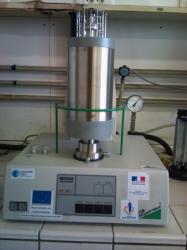
High temperatue differential scanning calorimetry
Research team: Métallurgie physique et génie des matériaux.
Contact: Rajashekhara SHABADI.
- High temperature furnace- 700-1500 ° C
- Low temperature furnace (
- Possibility of thermal cycling and simulation of rapid cooling
- Ability to analyze samples under He, Ar and / or N2
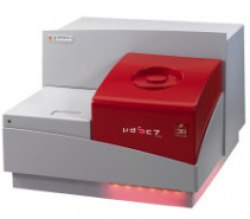
microcalorimeter MicroDSC7 evo (Setaram)
Research team: Matériaux moléculaires et thérapeutiques.
Contacts: Alain HEDOUX, Laurent PACCOU.
the μDSC7 evo can meet the requirements of a wide range of applications, especially in the following areas:- Life sciences - pharmaceutical: protein denaturation / aggregation in solution, powder or gel, solid state polymorphism, amorphism,
- Food: protein denaturation / aggregation, polysaccharide fusion / gelation, gelatin, starch, emulsion stability,
- Polymers: influence of pressure on glass transitions to supercritical conditions,
technical characteristics
- temperature range -45 ° C to 120 ° C
- programming speed from 0.001 to 2 ° C per min,
- Hastelloy cell volume up to 1 mL
- Use in isothermal mode (calorimeter) or temperature programming (DSC).
- Ability to study samples in all forms: liquid, gel, powder, solid.
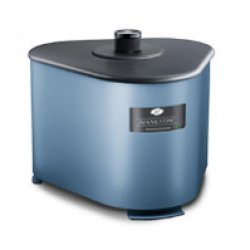
NanoDSC TA Instruments
Research team: Ingénierie des systèmes polymères.
Contact: Joël LYSKAWA.
Study of thermal transitions of polymers in dilute solutionTechnical characteristics:
- Temperature range: -10 to 130 ° C
- Cell volume: 0.3mL
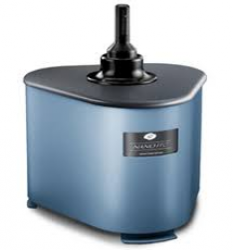
NanoITC TA Instruments
Research team: Ingénierie des systèmes polymères.
Contact: Joël LYSKAWA.
Study of molecular interactions and determination of association constants on diluted samplesTechnical characteristics:
- Temperature range: 2 to 80 ° C
- Volume of the cell: 1mL
Other thermal analysis techniques (2 instruments)
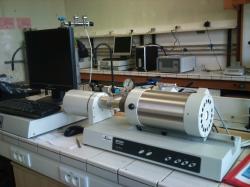
Dilatometer DIL 402C
Research team: Métallurgie physique et génie des matériaux.
Contact: Rajashekhara SHABADI.
Ambient temperature at 1500 ° C
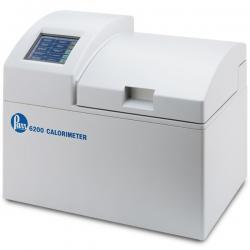
Oxygen combustion calorimeter (Parr 6200)
Research team: Ingénierie des systèmes polymères.
Contacts: Pierre BACHELET, Johan SARAZIN.
Measurement of the heat of combustion
thermogravimetric analyzes (7 instruments)
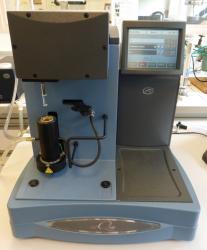
ATG Q500 (TA Instruments)
Research team: Matériaux moléculaires et thérapeutiques.
Contact: Florence DANEDE.
Characterization of solvent losses and degradations in molecular materialsTemperature range: from 30 ° C to 550 ° C
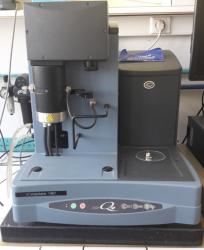
TA Q50 (TA Instruments)
Research team: Ingénierie des systèmes polymères.
Contact: Stéphanie DEGOUTIN.
microbalancefurnace : from ambient temperature to 900 ° C
Gas: O2, N2
Platinum or alumina crucible
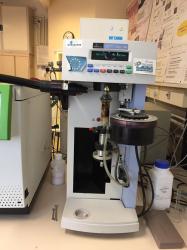
TGA Pyris 1 TGA (Perkin-Elmer)
Research team: Ingénierie des systèmes polymères.
Contact: Ulrich MASCHKE.
Technical characteristics:
- autosampler
- temperature range 20 ° C - 1000 ° C
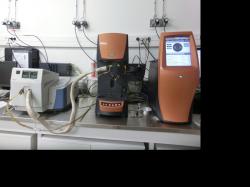
Thermogravimetric Analyzers TA Dicovery
Research team: Ingénierie des systèmes polymères.
Contacts: Pierre BACHELET, Johan SARAZIN.
ATG high speed (0.1 - 500 ° C / min) / FTIR coupling (IS10).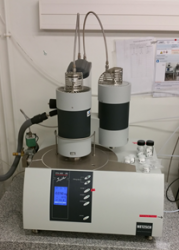
Thermogravimetric analyzers Netzsch STA449 F1 Jupiter
Research team: Ingénierie des systèmes polymères.
Contacts: Pierre BACHELET, Johan SARAZIN.
Simultaneous thermal analysis up to 1500 °C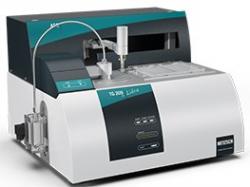
Thermogravimetric analyzers Netzsch TG209 F1 Libra
Research team: Ingénierie des systèmes polymères.
Contacts: Pierre BACHELET, Johan SARAZIN.
TGA. Equipped with a large sample changer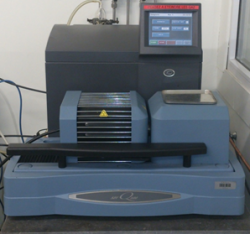
Thermogravimetric Analyzers TA Q600
Research team: Ingénierie des systèmes polymères.
Contacts: Pierre BACHELET, Johan SARAZIN.
Dynamic Thermal Simulation, up to 1500 °C.
